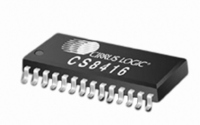CS8416-CNZ Cirrus Logic Inc, CS8416-CNZ Datasheet - Page 44

CS8416-CNZ
Manufacturer Part Number
CS8416-CNZ
Description
IC RCVR DGTL 192KHZ 28QFN COMM
Manufacturer
Cirrus Logic Inc
Type
Digital Audio Interface Receiverr
Datasheet
1.CS8416-CZZ.pdf
(60 pages)
Specifications of CS8416-CNZ
Applications
Digital Audio
Mounting Type
Surface Mount
Package / Case
28-QFN
Audio Control Type
Digital
Control Interface
I2C, SPI
Control / Process Application
AV & DVD Receivers, CD-R, Digital Mixing Consoles
Supply Voltage Range
3.13V To 5.25V, 3.13V To 3.46V
Lead Free Status / RoHS Status
Lead free / RoHS Compliant
For Use With
598-1017 - BOARD EVAL FOR CS8416 RCVR
Lead Free Status / RoHS Status
Lead free / RoHS Compliant, Lead free / RoHS Compliant
Other names
598-1723
44
14.14 Interrupt 1 Status (0Dh)
14.15 Q-Channel Subcode (0Eh - 17h)
ABS SECOND ABS SECOND ABS SECOND ABS SECOND ABS SECOND ABS SECOND ABS SECOND ABS SECOND
ABS MINUTE ABS MINUTE ABS MINUTE ABS MINUTE ABS MINUTE ABS MINUTE ABS MINUTE ABS MINUTE
ABS FRAME
CONTROL
SECOND
MINUTE
FRAME
TRACK
INDEX
ZERO
7
0
7
For all bits in this register, a “1” means the associated interrupt condition has occurred at least once since
the register was last read. A “0” means the associated interrupt condition has NOT occurred since the last
reading of the register. Reading the register resets all bits to 0, unless the interrupt mode is set to level and
the interrupt source is still true. Status bits that are masked off in the associated mask register will always
be “0” in this register.
PCCH – PC burst preamble change.
Indicates that the PC byte has changed from its previous value. If the IEC61937 bit in the Format Detect
Status register goes high, it will cause a PCCH interrupt even if the PC byte hasn’t changed since the last
time the IEC61937 bit went high.
OSLIP - Serial audio output port data slip interrupt
When the serial audio output port is in slave mode, and OLRCK is asynchronous to the port data source,
this bit will go high every time a data sample is dropped or repeated. See
page 25
DETC - D to E C-buffer transfer interrupt.
Indicates the completion of a D to E C-buffer transfer. See
page
C_CHANGE -Indicates that the current 10 bytes of channel status is different from the previous 10 bytes.
(5 bytes per channel)
RERR - A receiver error has occurred.
The Receiver Error register may be read to determine the nature of the error which caused the interrupt.
QCH – A new block of Q-subcode is available for reading. The data must be read within 588 AES3 frames
after the interrupt occurs to avoid corruption of the data by the next block.
FCH – Format Change: Goes high when the PCM, IEC61937, DTS_LD, DTS_CD, or DGTL_SIL bits in the
Format Detect Status register transition from 0 to 1. When these bits in the Format Detect Status register
transition from 1 to 0, an interrupt will not be generated.
Each byte is LSB first with respect to the 80 Q-subcode bits Q[79:0]. Thus, bit 7 of address 0Eh is Q[0] while
bit 0 of address 0Eh is Q[7]. Similarly, bit 0 of address 17h corresponds to Q[79].
51.
ABS FRAME
CONTROL
for more information.
SECOND
MINUTE
FRAME
TRACK
INDEX
PCCH
ZERO
6
6
ABS FRAME
CONTROL
SECOND
MINUTE
FRAME
TRACK
INDEX
OSLIP
ZERO
5
5
ABS FRAME
CONTROL
SECOND
MINUTE
FRAME
TRACK
INDEX
DETC
ZERO
4
4
ABS FRAME
ADDRESS
SECOND
MINUTE
TRACK
FRAME
INDEX
ZERO
CCH
3
3
“Channel Status Buffer Management” on
ABS FRAME
ADDRESS
SECOND
MINUTE
FRAME
TRACK
INDEX
RERR
ZERO
2
2
ABS FRAME
“Slip/Repeat Behavior” on
ADDRESS
SECOND
MINUTE
FRAME
TRACK
INDEX
ZERO
QCH
1
1
ABS FRAME
ADDRESS
SECOND
CS8416
MINUTE
FRAME
TRACK
INDEX
ZERO
DS578F3
FCH
0
0
















